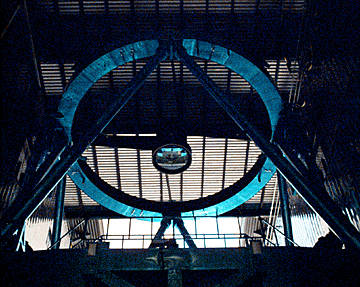


‘First Light’
on Mauna Kea
The $300 million project hits
By Rod Thompson
a milestone today with its
first usable picture
Star-BulletinMAUNA KEA, Hawaii - Astronomy is having a deep impact on human beings without their being aware of it, says Kazuhiro Sekiguchi of the Japanese national telescope on Mauna Kea.
The telescope named Subaru, for the stars known in English as the Pleiades, will begin its own contribution to the human psyche today when it transmits its first usable scientific picture, known as "first light."
Kazuhiro Sekiguchi: People ask: "Is there a God up there?
Is it worth spending money?"
His answer: "Do you put a
price tag on your God?"
The event marks a scientific milestone for the $300 million project featuring an instrument with a main mirror 27 feet across and housed in the largest building on Mauna Kea.For Sekiguchi, an astronomer, the process is also spiritual.
"It's affecting people deep inside their consciousness," he said.
As recently as 1920, people realized that the Milky Way is the galaxy we live in and that there are many other galaxies outside it, he said. And now we know about the Big Bang, in which the universe was created, and mysterious quasars on the edge of the universe.
"Some people in South Africa asked me, is there a God up there? Is it worth spending money?" he said.
Sekiguchi's response: "Do you put a price tag on your God?"
Despite the huge $300 million cost, which includes offices in Hawaii and Japan as well as the telescope, Sekiguchi said the price is relatively cheap. It represents the cost of a single cup of coffee for every person in Japan, he said.
Subaru will soon begin exploring questions astronomy has uncovered.
For example, what are the immensely bright but immensely distant quasars? A theory says they are matter throwing off light as it falls into a black hole, but no one really knows.
Sekiguchi believes Subaru will also be able to see planets around other stars for the first time.
The instrument that will do this features a mirror made of a single piece of glass 27.4 feet across. In comparison, the Gemini telescope under construction on the mountain will have a mirror 27.1 feet across, and the two Keck telescopes have mirrors made of a mosaic of pieces totaling 33 feet across.
"The Keck people just smile and say bigger is better," said private tour guide Doug Arnott.
Subaru astronomers say it's not so simple.
Keck can gather more light, astronomer Chris Simpson concedes. "We hope to produce crisper images," he said.

Keck and Gemini are limited to narrow areas of the sky at any given time. Subaru can look at narrow areas or wider areas nine times larger than Keck's view, Sekiguchi said.He also believes the tiny spaces between the pieces of Keck mirrors allow heat to enter, limiting Keck's ability to study infrared light.
Subaru is designed to work equally well with visible light or infrared.
Since heat is the enemy of infrared studies, and people generate heat, Subaru uses robots as much as possible to work on the telescope and keeps people away from it, said Subaru astronomer Ian Shelton.
In the thin atmosphere of the summit where brains are robbed of oxygen, people also make mistakes.
"The second you get people involved at 14,000 feet, it gets unpleasant," he said.
The unusual upright tubular shape of the building is designed to allow cold night air through the building, cooling the telescope, unlike normal domes that seek to protect telescopes from outside air, said Simpson.
While other telescopes of about 27 feet are under construction in Chile, that is the current limit in size for a single piece of glass because mirror makers don't have larger facilities, Sekiguchi said.
But in the quest to satisfy their psyches, some astronomers are talking about telescopes of nearly 53 feet, he said.
And some envision instruments with mirrors 100 feet across, to be built on the far side of the moon, he said.